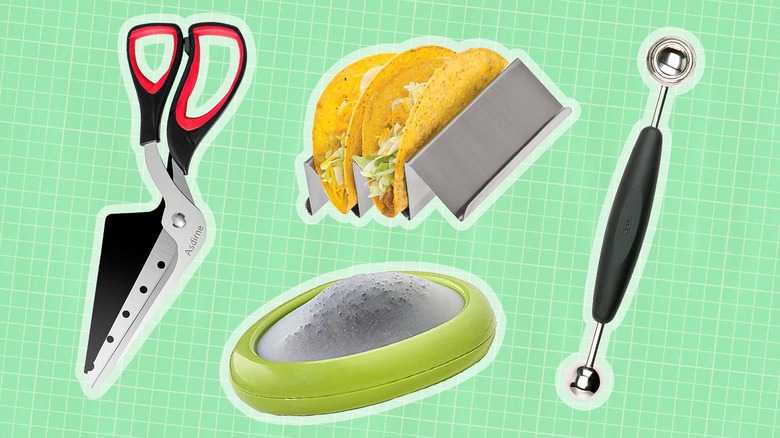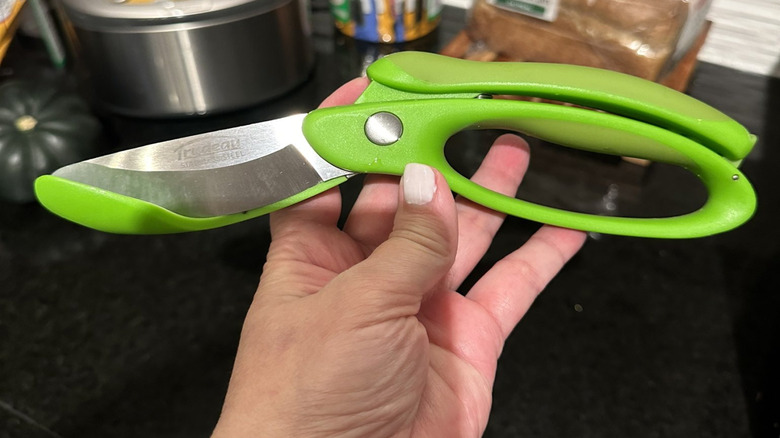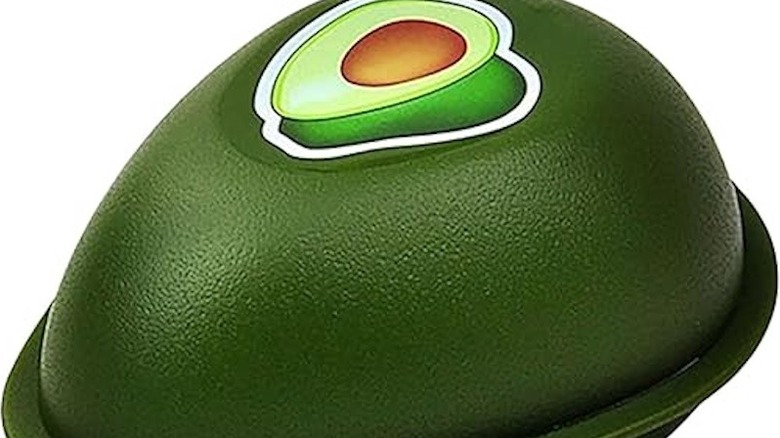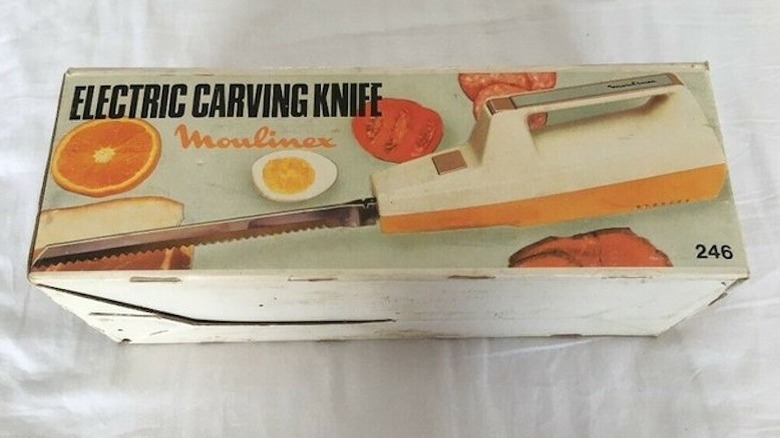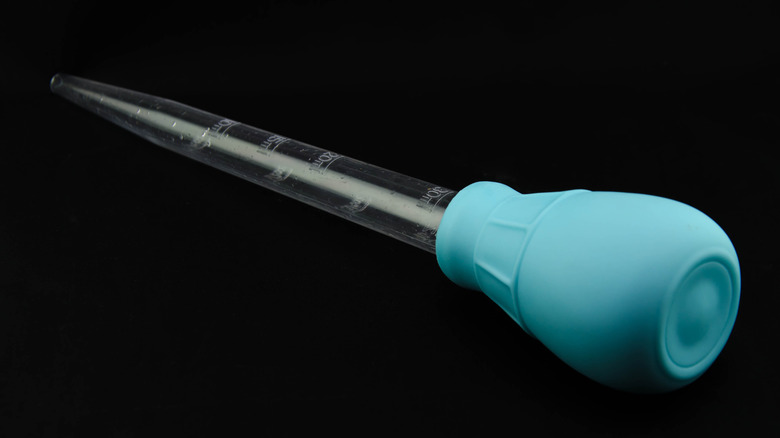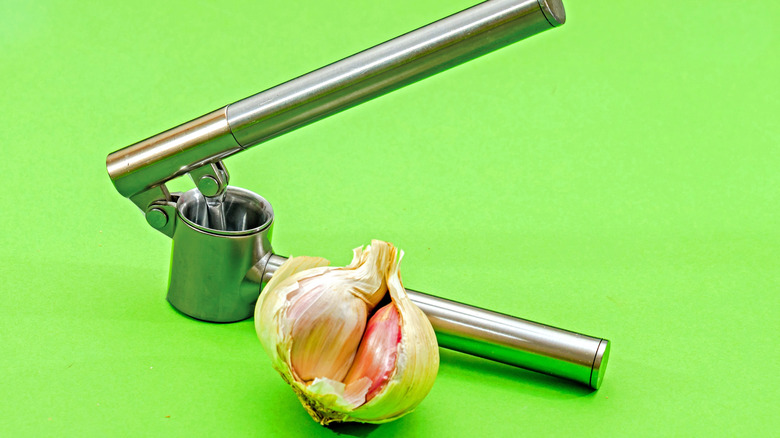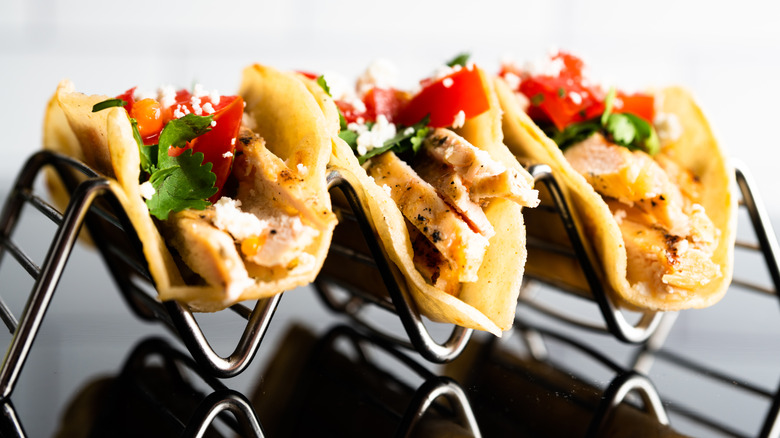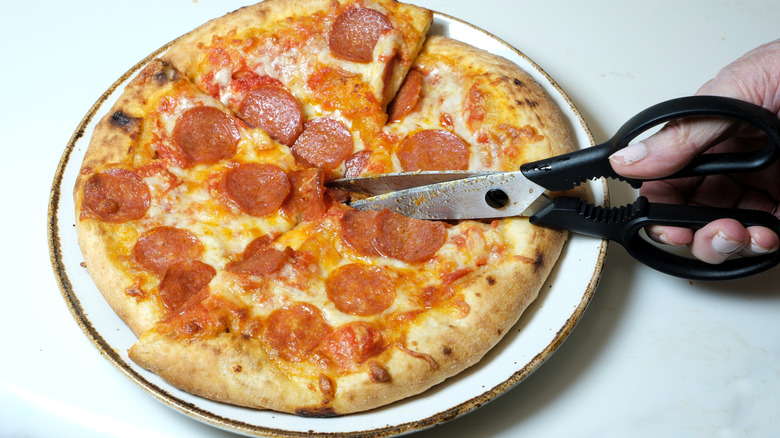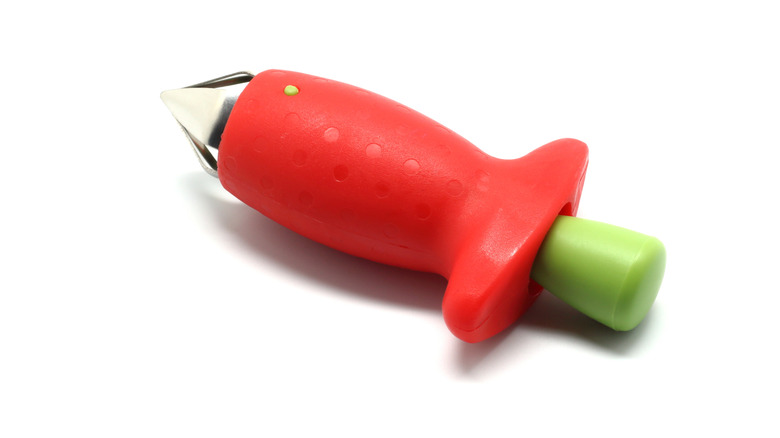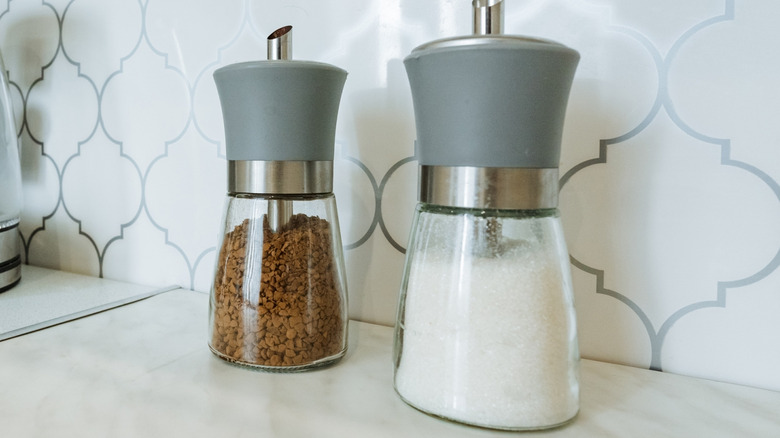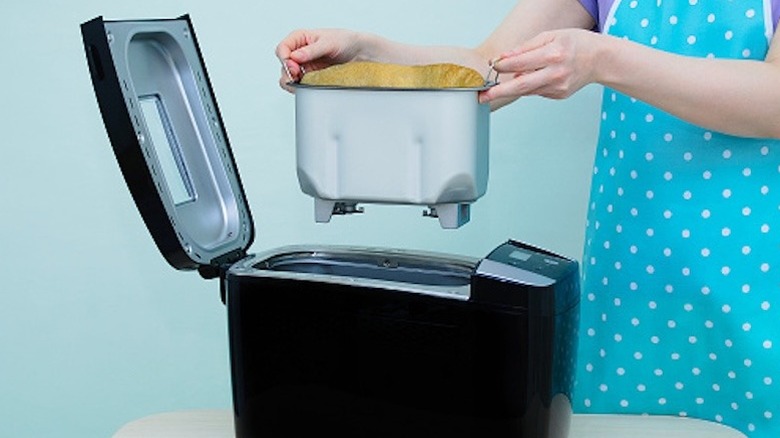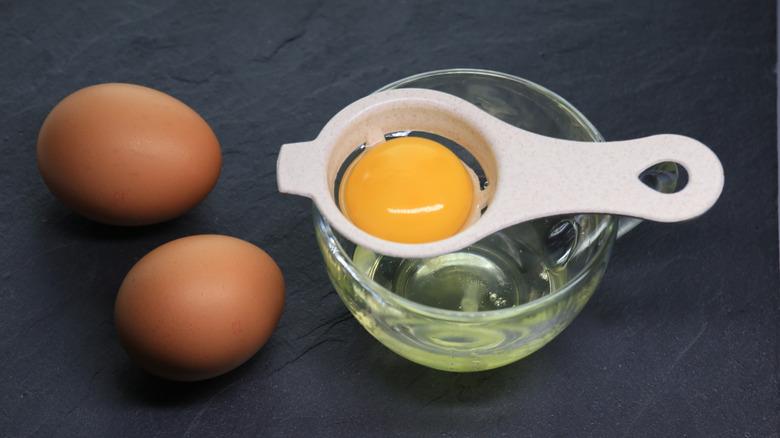Kitchen Tools You Shouldn't Waste Your Money Buying
Whenever an individual decides to cook at home more, they might head out to the kitchen supply store. One simply can't start cooking, or be a better foodie, if their space isn't outfitted with all of those alluring tools, gadgets, and machines, after all. But then, after they're used once or twice, those once exciting things are relegated to a crowded junk drawer or cubby hole. Or they're left out on the counter to remind the home cook and their loved ones about the money that was wasted on that dumb item that only ever did one thing, and not very well at that.
Some kitchen tools have been positively revolutionary; it's hard to imagine life before rice cookers, air fryers, and Tupperware. But there are far more bad ones. To get a handle on which seemingly practical gadgets are actually unnecessary, The Takeout sought out some experts: Recipe creator and internet food star Grace Vallo of Tastefully Grace; Chris Von Egger, regional chef of Halls Catch and Halls Chophouse in Nashville; Jeff Strauss, chef and partner at Oy Bar in Studio City, California, and Jeff's Table in Highland Park, California; Aaron Cuschieri, executive chef of The Dearborn and chef partner of The Dearborn Terminal 5 at O'Hare International Airport; and Jonathan Sawyer, James Beard Award-winning chef of Kindling in Chicago and a victor on Food Network's "24 in 24: Last Chef Standing."
Here, then, are all the food prep gadgets you don't need to buy, according to the pros.
Salad scissors
Any kitchen tool worth its price is going to save one of two things, or ideally both: time and labor. Salad scissors seem like they check both of those boxes while also potentially adding a little excitement to the meal preparation process. They're specially shaped and angled shears that allow the user to cut big and floppy lettuce leaves down to size, and right in the bowl. No more cutting board for you, salad scissors purchaser and user — that's just an extra step and another dish to wash later.
Salad scissors are pure consumerist nonsense, it would seem. The concept is completely foreign to people who make their living cooking or working in kitchens. "This is silly," declared chef Aaron Cuschieri. "I actually had to look it up when I read it. No professionals use these."
"As long as your knife is sharp, it's best to use a knife for greens," chef Chris Von Egger said. Not only is a knife sharper than novelty scissors, it's speedier, too. "A chef's knife works faster," said Grace Vallo of the salad tool. "Probably caught on because 'scissors in a bowl' feels fun and no cutting board needed."
Avocado saver pods
Avocados are both rich and relatively expensive, and saving half of one for another occasion is often the reasonable thing to do. The big problem with this fatty fruit is that they're famously temperamental. Even picking out the best avocados at the store yields a selection that's only ripe for so long. Once they're split open, they rot at a rapid pace, the exposure to air immediately leading to discoloration and other unappetizing characteristics. To remedy this problem that's universal among enjoyers of avocados, kitchenware companies have developed a whole emerging sub-genre of avocado savers, also known as avocado pods. Invariably made to look like an avocado, or sharing its green color, they're also not much larger than an avocado. That means less air inside to get its way all over the leftover half.
No matter the design, an avocado pod is essentially an avocado-shaped piece of plastic. Nothing else is going to fit those dimensions, rendering it a single-use item, and so buying one isn't a very efficient use of money. Nor can the average avocado saver even do what it's supposed to do, and save an avocado. There's still dangerous air inside. "Those green plastic holders never really keep them fresh," said Grace Vallo.
Electric carving knife
"Feels very '70s," Grace Vallo of Tastefully Grace accurately observed of the electric carving knife. These tabletop saws seemed to show up in every home in the mid-20th century on special occasions to carve a rib roast or the best Thanksgiving turkey possible in front of a hungry crowd. It almost guaranteed that everyone assembled would get to start eating that much quicker, because they could so quickly and easily move through meat. In reality, however, the mini appliance was a major menace.
"I'm old enough to remember when they were popular in the '70s and sent literally dozens of people I knew (mostly non-cooking, turkey-carving dads) to the hospital needing stitches because they vibrated really quickly and you couldn't 'see' that they were on, so people touched the blades to check," recalled chef Jeff Strauss. "Sharpen your knives and move your hand back and forth."
Chef Chris Von Egger believes the item has its uses, although in a limited capacity. "There's something about carving a turkey with one of these," he said. "It also makes the job quick and easy, but it's not as practical as one would think. You really only pull it out to use once a year." As far as its use in a restaurant, that's a non-starter. "As a professional we would never use one of these," said chef Aaron Cuschieri. "A long sharp slicing knife is all the professional cook needs to carve turkey."
Turkey baster
One of the oldest and simplest tools still rolling around the kitchen drawers of the world is the baster, often called a turkey baster, to refer to the one thing it's most likely used for, and once a year at most. In the often nerve-wracking process of preparing a large roasted turkey for a holiday meal, home cooks may obsess over the moistness and flavor of the bird. Periodically returning the delicious juices and fat cooked out of the turkey to the dish is important, and that's done with a baster. One simply dips the open end of the tube part into the pan drippings and squeezes the ball on the other side, allowing suction to capture the juices. Another squeeze dumps the liquid right back onto the turkey.
It's all very straightforward and obvious, but is it worth keeping a baster around the kitchen, or buying one before hosting the annual family holiday dinner? Not really, according to some experts. "Basting is a good thing," said chef Jeff Strauss. "I use a spoon." Chef Aaron Cuschieri also believes in the power of basting, but has found there are better tools around. "When I baste my turkey or chicken or anything I use a pastry brush," he explained. "It's a more even and intentional coating of juice or butter." And the turkey baster? "It's not silly but it's also not needed either," said Cuschieri.
Garlic crusher
Sometimes also called a garlic press, a garlic crusher is a kitchen tool that looks more like an industrial implement. It results in finely minced garlic in a snap, provided that the cook puts in substantial effort beforehand. They've first got to peel the skin off the bulb of garlic, pry off a clove, remove its tightly-fitting coating, and place the raw and naked piece into the chamber on the press, and then squeeze. It gets almost all of the edible product out of there, all juicy and minced.
According to the experts, a garlic crusher introduces more labor than it saves. "A sharp chef's knife does the job faster, cleaner, and with way less fuss," explained chef Jonathan Sawyer. "Crushing garlic under the flat side of the blade releases all those natural oils and aromas you actually want — whereas a garlic press just turns it into a weird paste and leaves half of it stuck inside. I think they caught on because they look like they make life easier, but once you know your way around a knife, you realize it's the simpler and better tool."
Other experts concur. "I'd rather smash with a knife. Less to clean. But they sell because people like 'special tools' that promise shortcuts!" said Grace Vallo. "Personally, this is not needed, especially once you know how to properly utilize a knife," added chef Chris Von Egger. Even Ina Garten thinks garlic presses are overrated.
Taco holders
It's more than fine that every brew pub, bistro, and Mexican fusion place in the country serves tacos, generally in a self-declared elevated form or made with fish, chicken, or lots of vegetables. In adapting tacos for restaurant patrons, chefs seem to have made tacos extra messy, piled high as they are with toppings and sauces. The solution, at least in the kinds of restaurants that make their own beer and seat their customers on uncomfortable backless chairs: taco holders. Sometimes they're little slabs of metal, sometimes they're racks. But they're always shaped like multiple instances of the letter V, and a taco gets nestled in that little dip.
One might be tempted to buy some of these to give a restaurant-style edge in pursuit of a hassle-free taco night at home. That's probably going to be a waste of money, though. "A regular plate works, but they do make tacos look tidy and less messy," said Grace Vallo of Tastefully Grace. "These are terrible," suggested chef Aaron Cuschieri. "At least for anyone above the age of 10." Tacos, after all, are a fast food and a street food, and not supposed to be pretentious enough to require something to keep them in place. "Hands are taco holders, no?" chef Jeff Strauss asked rhetorically.
Pizza scissors
So many new kitchen gadgets that come along are bolstered by marketing materials that claim to be a solution to a problem no one knew we had. For example, the marvelously simple and highly effective wheel-style cutter has been pretty much the universal way to slice a pizza, in restaurants and at home, for as long as anyone can remember. But then along came pizza scissors, purporting to improve on the wheel.
Rather than hold onto the wheel's handle and drive it through the pie, pizza scissors are just scissors that can cut through crust, sauce, and cheese all at once. Sometimes, pizza scissors come with a built-in spatula, suggesting that this one tool can replace the two implements needed to serve homemade or frozen pizza.
As it turns out, it's tough to improve on the round blade device, which is really just a knife on an axle. Pizza scissors are inconsistent, gimmicky, and a home cook doesn't really need them. "I'll admit they look clever, but a wheel or big knife is just easier," said Grace Vallo. "The idea is that it's better than the wheel because it doesn't pull your toppings off," theorized chef Aaron Cuschieri. In reality? "You're less likely to get even cuts with scissors," he said.
Single-purpose fruit tools
It's certainly possible to eat too much fruit, especially when so much good produce is available year-round, or particularly delicious when it's in season. Fruit is a wide and often weird world, and there are numerous ways to approach the different kinds. Some can be eaten whole, while some must have their pits, peels, or tops removed to be edible. The kitchenware industry knows which fruits require minor surgery before serving, and companies have released all sorts of merchandise that's usually small, inexpensive, and designed to do exactly one thing to one fruit.
According to chefs and food experts, these single-purpose fruit tools are likely way too specialized for the average home cook, and thus an unnecessary expenditure. Chef Chris Von Egger believes only next-level cooks need such objects. "Not necessarily needed for at-home chefs, unless you're making a lot of fruit displays," he said. "Otherwise, they can be used in restaurants, but I'd say it still depends on how many fruit-related applications you need them for." With regards to a strawberry huller or a melon baller, Grace Vallo of Tastefully Grace says that "a spoon or paring knife does the trick, adding "but they feel fun and 'pro-kitchen-y.'"
Food choppers and electric spice grinders
Plenty of infomercials and catalogs have tried to sell home cooks of all abilities and levels of experience on a variety of rapidly operating food chopping devices. Whether they spring into action by pressing down on a plunger or make use of a battery, they do indeed obliterate, pulverize, and nearly powderize anything put inside of them, be it fruit, vegetables, or nuts. But these are not really problem-solving gadgets — more likely they're cheaply-made and redundant, and not worth even a small price. "Food chopper things with the lid and the plastic bin to catch the stuff," are, according to Jeff Strauss, "bulls***." Cooks and chefs have long made due with a sharp knife for small batches of ingredients that need to be finely minced or chopped, or a food processor for bigger tasks.
Similar to food choppers are fully-automated salt and pepper shakers that hold whole rocks or corns and, when a button is pressed, grind down just enough usable seasoning. These are literally electric salt and pepper shakers, which some experts may think is a laughable notion. "Electric salt and pepper grinders work if you don't have working wrists," said Strauss. "If you need to grind a lot of something, use a big grinder or a blender. Otherwise save the batteries, the counter space, and the planet."
Electric bread machine
First available in the late 1980s, electric bread machines became a certifiable fad in the early 1990s, with four million early adopters shelling out several hundred bucks for an intriguing metal and plastic box that automated every step of the arduous process of making a loaf of bread from scratch. One simply poured in the ingredients, and the bread machine would stir, knead, and bake. By that point, most Americans had gotten used to eating store-bought bread; these bread machines promised a return to the homemade bread of a bygone era, made possible with modern technology.
Bread makers are convenient but have some major downsides, and the product has almost always been perceived as lackluster. That's still the general opinion up until the present day, with many chefs and experts remaining very unimpressed with the bread one gets out of a machine that could cost a few hundred dollars or more. "These are fine in theory, but are nothing that a mixer can't do," said chef Chris Von Egger.
"It's a gadget, even if you or somebody you know has made 'fantastic bread' with one," dismissed chef Jeff Strauss. "Warm dough has a way of tricking our brains into thinking everything is right with the world. Nobody has ever made truly great bread in one of those." Chef Aaron Cuschieri was even more direct: "Don't make bread in a bread machine."
Egg separator
Resembling a tiny strainer or colander, and made of plastic, an egg separator consists of a short handle connected to a bowl-like depression covered in narrow and thin cutouts. That area is large enough to hold a single egg yolk, and that's the egg separator's entire purpose. Some recipes call for just the rich and yellow egg yolks, and others call for only the albumen, or the semi-transulcent and viscous fluid that turns white when cooked or whipped. The egg separator makes the separation happen. One is simply to crack an egg and dump it into the separator that's been suspended or held over a bowl. The whites drips down through the slots into the bowl, while the yolk — or yolks, as some eggs have two yolks – remain whole and intact in the chamber of the separator.
The egg separator accomplishes one of the easiest most rudimentary tasks in all of cooking. But it's really not that hard to separate an egg yolk from an egg white, and people have been able to do that for centuries before the gadget was invented. One can crack an egg and move the wet, raw, mess from hand to hand, allowing the whites to slowly drip down into a bowl and leaving the yolk behind. Hands are the original egg separator, in other words. "Don't even," chef Jeff Strauss said of this tool.
